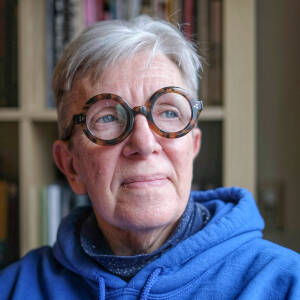Sue and Vivian Maier
I can’t ever enumerate the gifts Sue is, and has given, to me. Most recently, she gave me Pamela Bannos’ long-awaited biography of Vivian Maier, and let me say this: EVERYONE WHO CARES ABOUT PHOTOGRAPHS AND PHOTOGRAPHY SHOULD READ THIS BOOK!
Here’s why. Back in 2012-13, many of us first glimpsed the work of Vivian Maier, and despite the fact that her work was publicized by young men who never knew her and who profited enormously from her work while she died in poverty; despite the fact that the photos we could see were printed, cropped, exhibited, and sold without her knowledge or approval--we found her work fascinating. If you do a Blip search for #vivianmaier you will see that she attracted interest from many of us. There was a so-called documentary by John Maloof, who profits from her work. There was a BBC documentary that relied heavily on Maloof’s work.
Maloof views Maier as an eccentric, perhaps slightly mad nanny who had an obsession with the camera. He has no understanding of gender, economic privilege, or class and its affect on a woman artist. Bannos sees Maier as a woman photographer of very limited means who makes her living in the only way she can, who studies and hones her craft, who experiments with exposure, depth of field, filters, and dark room techniques, and who is influenced by the work of Eugene Atget, Lisette Model, Alfred Steiglitz, and other art photographers of her time.
Bannos’ book is braid of three themes: a history of photography, a history of Maier’s life, and a history of the commercialization of Maier’s work and the creation of a false image of Maier that has served those who sell her work. Bannos assembles thousands of tiny negatives, puts them in order by date, and reconstructs--and follows, herself--Maier’s steps as she walks through rural France, New York, Chicago, and all the places in Maier’s photographs. Bannos studies the photographs and the gestures of the people in them, noting how the poses and expressions change as Maier takes a first, second, third, or eighth photograph of the same person on the same day. Bannos examines the changing light on any given day to reconstruct, for example, the hours it took Maier to walk to a museum to see a photography exhibit, the number of hours Maier spent at the exhibit, and the photographs she took on the way home from the museum.
Bannos respects Maier as a serious photographer. She says in her introduction: “To get the right picture, look at her squarely, as she would look at you: on her own terms, from her own evidence of who she was and what she did” (p. 1). I’m only half-way through the book, and I’m taking notes. I feel my own photography will improve as I incorporate Bannos’ way of looking at photography and as I come to understand what it is that I love about Maier’s work.

Comments New comments are not currently accepted on this journal.